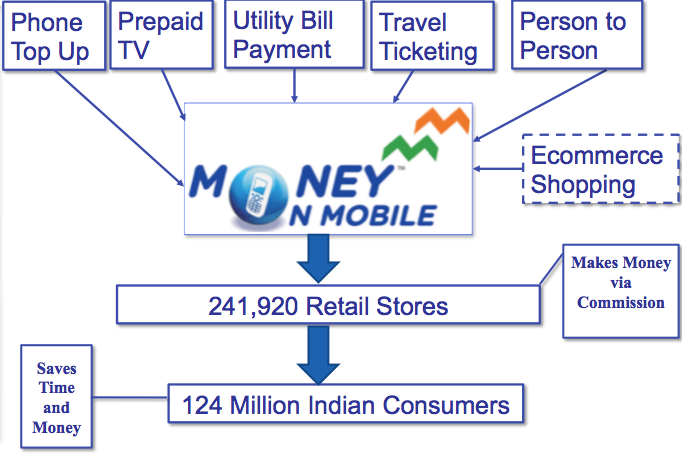Igniting Mobile Money In India
For most of the developed business world, the phrase “time is money,” is about using time better in order to maximize capital production. For most of India — the cash-centric, developing economy of 1.3 billion people — the phrase “time is money” has an entirely different meaning.
As in having to take a day off to walk to the utility provider to pay a bill – in cash.
What also has a different meaning is what it means to use “mobile money.” For instance, the most commonly used definition of mobile money applies to cross-border remittances – when Person A in Country A sends Person B in Country B money.
But for MoneyOnMobile — one of India’s leading mobile payment solutions — mashing up the notion of “time is money” with mobile payments is their entire business – a business that has generated a user base of 121 million users and 236,000 merchants to enable their mobile money solution.
Shashank Joshi, President for MoneyOnMobile, recently chatted with MPD CEO Karen Webster about how his company has shifted the mobile money paradigm in India – and redefined what it means to deliver “money on mobile.” Joshi explained that most consumers in the region don’t have a trust for many mobile money options since there isn’t the human connection that the cash-driven population relies on and trusts in. But MoneyOnMobile’s retailer-assisted model enables face-to-face interaction between the consumer and merchant, while transactions themselves are done via a mobile phone.
MoneyOnMobile, a subsidiary of U.S.-based Calpian, has found a way to provide a mobile payment solution to India’s urban and rural populations — a region in which 600 million people are unbanked, according to MoneyOnMobile. India has more mobile phone users than bank branches by a factor of roughly 40, and by some estimates, there are said to be 600 some million with mobile phones in the country that has around 150,000 bank branches. And that’s in a country of 1.3 billion people. The bottom line is that this mobile-phone toting population is heavily cash-centric. And so when it comes to bill payments, it’s all about going to each of the major billers, in person, to pay in cash.
Imagine this scenario.
A woman living in India needs to pay six bills. Before MoneyOnMobile launched in 2010, without a bank account, she had to visit all six of those physical locations – in person – to pay her bills. That often meant taking two or three buses and most of the day in line at the packed payment centers. The loss of wages that day only added to the cost of paying those bills.
And since her monthly family income is $200-$300 dollars a month, time really is money, money that she and her family cannot afford to lose.
Enter MoneyOnMobile — and its retailer assisted mobile payments network.
Now that woman can visit a shop in her neighborhood and present the retailer with cash to “top up” her MoneyOnMobile account. She can then use that account to pay her bills via using her mobile phone – her mobile and DTH recharge bills, her utility bills – she can even buy goods in that store – all with the click of a button using her MoneyOnMobile mobile wallet feature. She can avoid the trip to her six billers, and spend her time working and making money for her family. Unlike many mobile money schemes, MoneyOnMobile works on any basic mobile phone.
Here’s how the service works:
“Stop at nothing. Pay for anything.”
In the past year alone, MoneyOnMobile has grown from 107 million users and 219,00 retail distribution networks in October 2014 to the 121 million users across 236,000 retail distribution networks. Each month, the service has managed to engage roughly 5 million users and another 5,000 or 6,000 retailers as part of its retailer network. MoneyOnMobile is managing to process about 16 million transactions a month, according to Calpian CEO Harold Montgomery.
“I think the dynamism of India is really just becoming unleashed now. We’ve clocked 121 million unique users in three years,” he said in a recent interview. “The demand for what we do in India is so strong because there’s really not a substitute. I think we’re going to keep growing aggressively for the next several years.”
Joshi says MoneyOnMobile’s retail-assisted model is what’s contributed to MoneyOnMobile’s success in India. Allowing consumers to pay in cash, and being able to later execute that transaction using a mobile phone has eliminated the friction associated with how bills are paid, creating a base of consumers who can be enabled for other mobile transactions as well. And, gotten the stamp of approval from the Reserve Bank of India.
Joshi says that MoneyOnMobile not only managed to overcome India’s regulatory hurdles in a way that regulators not only allow, but approve of. Because cash-out transfers are not permitted in India, MoneyOnMobile had to work around this constraint to bring a new way for consumers to access their cash – thus making cash in digital and cash out – bill payments.
“Cash out is a paradigm and we need to work on that paradigm. And the way we are doing that now is increasing the retailer acceptance of MoneyOnMobile,” Joshi said, later noting that MoneyOnMobile has been a way to change the financial ecosystem by adding low-value transactions in an electronic method in ways that were not previously economically feasible.
“MoneyOnMobile can handle low value transactions that enables an entire realm of transactions that are below minimum cost thresholds,” Joshi said.
Not only is MobileOnMoney changing the way people pay for things, it’s also given them an outlet to pay for services on the go.
Just let this video speak for itself.


